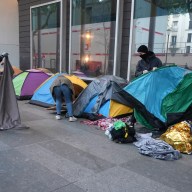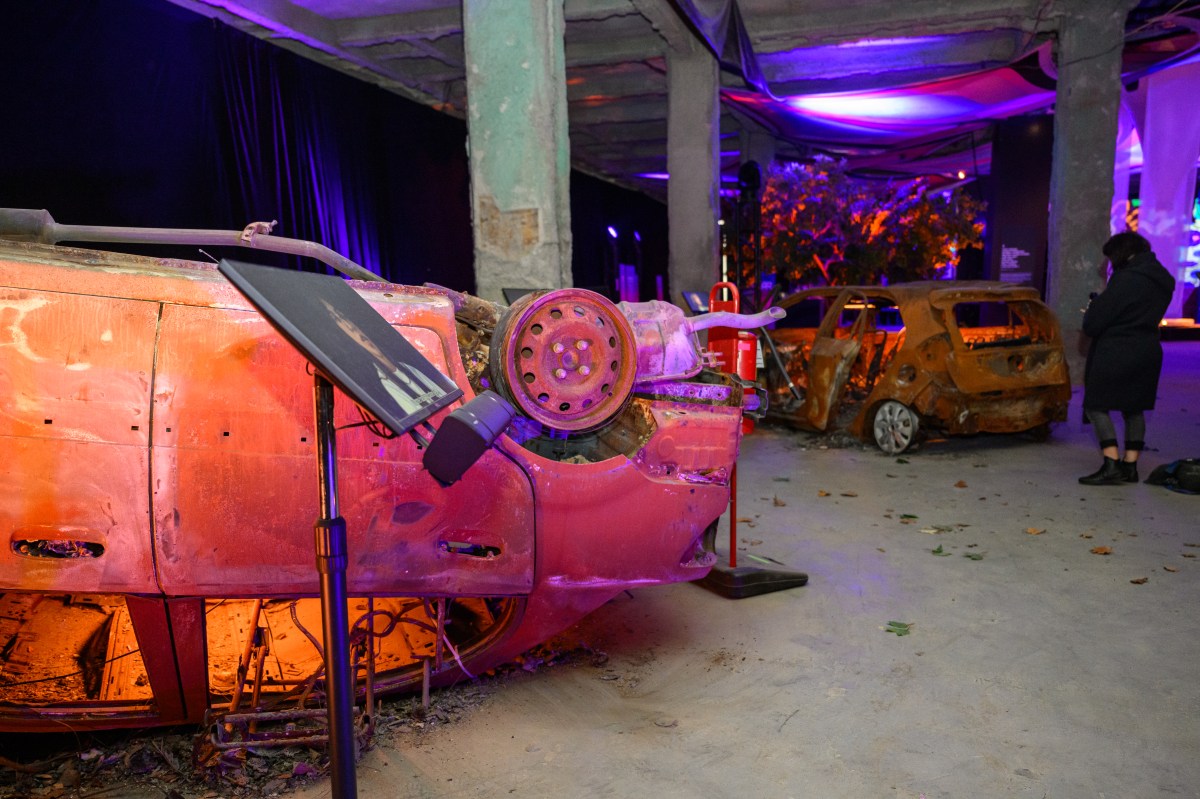“Feminist cannibal movie.” That’s the logline on “Raw,” a new French-Belgian shocker that had viewers running for the exits at Cannes last year, hands clutched to mouth. But, as Julia Ducournau, its writer and director, points out it’s really not that gory. And it’s also a character study (and a comedy). Garance Marillier plays Justine, a freshman collegiate (and vegetarian) who, during the school’s sadistically creative hazing process, develops a hankering for not just meat but human flesh. For her feature debut, Ducournau spent three years polishing her script, and thinking through its heady, disturbing, transgressive ideas, including the notion that Justine’s newfound diet can, if you will, if you look at it a certain way, be a good thing (sort of). We talked to the French filmmaker about hazing, body shaming and what her star really eats when she’s gnawing on body parts.
I was dismayed to discover hazing happens in Europe, too. I assumed it was a dumb American thing. I suppose I never really considered it. RELATED: Review: Feminist cannibal movie “Raw” will do more than make you puke I think we’re often a society that has learned to prize individuality, so it’s been shocking to learn over the last two years how much people enjoy blind conformity. The scene of her eating human flesh for the first time is a very sensual, strangely positive scene. Justine is discovering her body and what makes her special. Without making it explicit, the film addresses the idea of body shaming — of having a body that’s different from the norm. There’s also no sense of sexualization when you show their bodies, which tends to happen when you see a film about a woman discovering her sexuality. I knew I had more to say if it was a young woman. Because I do think the way female bodies are treated on our screens is through sexualization or glamorization. It’s either to attract a male audience through sexualization or set high expectations on women through glamorization. And there is no truth in that. No one can relate to that. It’s all about fantasy, projected on the female body. I don’t think there is the same fantasy about male bodies. I wanted to portray a female body in a way that is relatable to everyone. This girl’s body should be everyone’s body, beyond gender or race or religion. And it’s interesting because it’s a female body. Somehow I wanted to take the female body outside of its niche and find the truth in its trivialities. She has fluids, she has gas, she’s not always pretty, she’s awkward, as we all are in private. One of the most horrifying scenes has nothing to do with cannibalism. It’s where Justine’s sister gives her a bikini wax. It’s brutal, with close-ups of her hair being torn from her skin. But at the same time I didn’t want to make a scene that was just a wink-wink to all the women in the room. My point was to make it universal. So I shot it in a way so that everyone would feel that hair pulling from skin. If I did it to your torso or on your arm, it would be just as painful. You don’t need to have lived through [a bikini wax] to understand what she’s going through. That’s why the close-ups [of it] are so close. It takes you out of a ritual that is accordingly feminine, and it just becomes reduced to hair pulling on skin. That is the essence of this universal empathy. RELATED: You’ve been underestimating Kristen Stewart — and you need to stop Onto the gore! In a lot of cannibal movies the gore is clearly fake, but the ones here look natural and organic. It’s funny, because the most spectacular scene, which is the scene in the middle [where Justine eats her sister’s severed finger], if you look at it twice, it’s not that gory at all. There is only one close-up. The rest is medium shots, and you don’t see much because everything is hidden behind her fingers. You have to use your imagination. Making the audience use their imagination is much more interesting than going [makes an explosion noise and gesture] full blast. That’s why it’s disturbing. Was it difficult to get the effects just right? Was this difficult to finance? Most gory French movies tend to be straight-up horror movies, like “Inside” and “High Tension.” This is also a character study. Still, there were questions raised about my script. It wasn’t about the gory scenes; it was about the crossover aspect of the movie. Because it is, as you say, a character study and a horror film. They were like, “What is it, really?” I said, “It’s both. And it’s a comedy as well, because it’s funny.” They were like, “We don’t have crossovers in France. Pick a genre!” I said, “I’m not going to pick a genre! This is the identity of my movie!”
Really?
When you think about it, it makes sense, that it exists in every country in the world. It’s about people having power over other people, for the sake of fitting in. We live in a world where, apparently, fitting in is a very popular thing. The funny thing is when we decided to shoot in Belgium, because I had a crush on this location, I had absolutely no idea there was hazing there as well. I thought it was a stupid French-American thing. But, no, it’s worldwide. [Laughs]
I’m not sure it’s enjoyment, really. It comes out of fear. You’re afraid to be banned or shunned. The idea here is this girl really wants to fit in in the beginning, but then she discovers something that makes her an outsider. She wonders if it’s possible to live outside the box that everyone wants to get into. I do believe that being outside the box is always a good thing. That’s why I came up with the idea that monstrosity can be a positive thing, in a way. You’re trying to find yourself in a way that is not defined by anyone else.
Yes, and more importantly she learns to define her own moral standards when confronted with her nature — the dangerous side of her nature. In the beginning it’s sort of a rebellion against the establishment, the hazing. But at the same time there is a positive effect to this nature. She really asks herself the question, “I can kill, but will I?” The whole point is that she does not. What she does it monstrous, but she build up a moral canvass around it. She finally manages to perceive what’s right and wrong in her world.
There are hints in the movie about the way that female bodies are treated and the expectations that go with it in our society. For example, when one girl throws up, her friend says, in the most natural and normal way, that it would come up faster with two fingers. It is funny; it’s meant to be a funny scene. But at the same time it’s tragic the way she tells her that, like it’s normal behavior.
At one point I thought it could be a young man who discovers his nature. But I knew I was going to be filming bodies a lot, because I’m very interested in filming bodies, in a way that reveals humanity without words. I also knew I would be talking about sexuality a lot, because this is the age when you discover your sexuality and define yourself through that.
I was thinking about the absurdity of the violence it represents. You have to do it because society says hair on women is bad. I’m not shaming anyone; I do it, my friends do it, we all do it. But because I do it, I question it. It’s a typically female practice. I don’t think it’s fair.
I think the reason you feel that way is because there are very few cannibal scenes in the movie. If you had a steady accumulation of cannibal scenes you would be desensitized to it. You would have felt they were cheesy. It’s about the balance of what you show and what you don’t show. I really don’t like gratuitous violence, because it makes me feel nothing. It’s not like it shocks me. I just don’t give a damn at some point. I look at it, and I’m like, “Nah.” If it doesn’t say anything about the character, I’m not interested.
It’s not hard, but it takes time. I really favored on-set special effects. I love working with prosthetics and silicone and candies. Most of the things she eats are just candy. I only have a bit of CGI in the movie, because I think the CGI should only go where the prosthetics can’t. [VAGUE-ISH SPOILER] For example, at the end you have [a character’s eaten-away leg]. Obviously you can’t carve the leg for real. So you have to use CGI. That’s the only moment I use it.
In France, it’s really hard to finance a genre movie. It’s way harder than here. For some reason in France, you can’t be an auteur if you make genre films. I don’t know why. We used to have great genre directors who are considered auteurs, in the ’30s, the ’40s, the ’50s, the ’60s. But not now. I was expecting some industrial crash when I was writing the movie — like, “Oh, this is too f—ed up, I’m never going to get financing.” But we went through my producers, and I must say we are kind of an exception right now in France, because it’s never easy to to get money, never. But it was less complicated than we thought. It was classical. But we are an exception.
‘Raw’ director Julia Ducournau on how to make a feminist cannibal movie
Follow Matt Prigge on Twitter @mattprigge


















